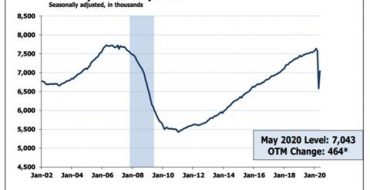
US construction employment rebounded by 464,000 jobs in May, but the total remained 596,000 below the latest peak in February and the industry’s 12.7% unemployment rate was the highest for May since 2012, according to an analysis of government data by the Associated General Contractors of America (AGC).
The gain of 464,000 jobs in May followed losses of 995,000 in April and 65,000 in March, for a cumulative loss over three months of 596,000, due to the effects of the Covid-19 pandemic. Construction employment totaled 7,043,000 in May, about where it stood in late 2017, noted Ken Simonson, AGC chief economist.
“The huge pickup in construction employment in May is good news and probably reflects the industry’s widespread receipt of Paycheck Protection Programme loans and the loosening of restrictions on business activity in some states,” Simonson said. “Nevertheless, the industry remains far short of full employment, and more layoffs may be imminent.”
Association officials cautioned that future job losses are likely as temporary federal support programmes end, state and local officials deal with tighter budgets and private sector demand declines later this year.
AGC officials said the best way to avoid the expected future construction job losses is for federal officials to boost funding for infrastructure, including highway, bridges, waterways and airports. They noted the additional funding would help cover expected state and local budget shortfalls and would help replace expected declines in private sector demand.
“Government officials have done a good job providing temporary relief for firms struggling to cope with the economic impacts of the pandemic,” said Stephen E. Sandherr, the association’s chief executive officer. “As those temporary supports end, the broader economic realities of the lockdowns will cost countless construction jobs unless Congress and the [Trump] Administration can work together to enact measures to revive the economy.”
AGC’s latest survey found that nearly one fourth of contractors reported a project that was scheduled to start in June or later had been canceled. With most states and localities starting a new fiscal year on 1 July, even more public construction is likely to be canceled unless the US federal government makes up for some of their lost revenue and unbudgeted expenses, officials said.
The industry’s unemployment rate in May was 12.7%, with 1,187,000 former construction workers idled. These figures were roughly four times as high as in May 2019 and were the highest May levels since 2012 and 2011, respectively.
Original article: https://www.khl.com/international-construction/us-construction-jobs-rebound-in-may/144552.article